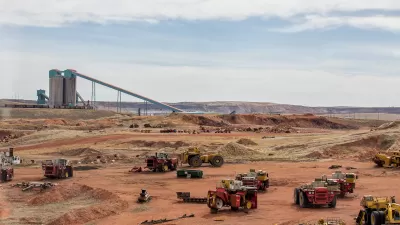The breach of the coal ash landfill by a former coal-burning power plant in Wilmington, North Carolina serves as a reminder that even after coal plants are shuttered, the by-products of the world's most polluting fossil fuel can still cause harm.
"Record-breaking rains from Hurricane Florence caused the release of more than 2,000 cubic yards of coal ash from a Duke Energy power plant in North Carolina, the utility announced Sunday, some of which may have reached nearby waterways," reports Gavin Bade for Utility Dive on Monday.
The Category 1 hurricane made landfall on Friday morning, Sept. 13, near Wilmington, where the Sutton Plant is also located. Rainfall totals in the city of 119,000 were 26.58 inches as of Sept. 17.
Erosion from rains caused the failure of a slope storing ash in a pond [sic] at the Sutton power plant, the utility said. Some of the ash may have reached Sutton Lake, the cooling pond for the plant that is used for recreation by residents in the area.
The amount of coal ash released from the Sutton plant is relatively small compared to major spills [such as the 2014 Dan River spill in Eden, N.C. posted here], but it underscores the inherent risks of storing the waste product in close proximity to waterways and local communities.
Sutton Plant now operates as a 625-megawatt natural gas combined-cycle plant after the coal plant was retired in 2013 and removed in 2017. However, the coal ash, created when coal is burned by power plants to produce electricity, and one of the largest types of industrial waste generated in the United States, according to the U.S. Environmental Protection Agency, remained on-site. How it is stored is an issue of considerable controversy.
"This spill illustrates the dangers of Duke Energy’s practice of disposing of coal ash near waterways throughout North and South Carolina," said Frank Holleman, senior attorney at the Southern Environmental Law Center, on Sept. 16. "Disposing of coal ash close to waterways is hazardous, and Duke Energy compounds the problem by leaving most of its ash in primitive unlined pits filled with water."
According to another environmental watchdog, Cape Fear Riverkeeper, affiliated with the Waterkeeper Alliance, "[t]he release occurred when Hurricane Florence flood waters washed coal ash from a landfill near Lake Sutton," so it's not clear to this correspondent whether the ash was stored in a pond or landfill, or perhaps a combination of the two.
Southeast Coal Ash.org, a service of the Southern Alliance for Clean Energy, a nonprofit organization that "promotes responsible energy choices," describes two types of storage: wet storage or impoundment and dry storage or landfills. I'll go with WRAL.com and call it a landfill.
"As the weather clears, state officials will inspect the facility to better assess the spill and how much ash may have entered Sutton Lake or the nearby Cape Fear River, the North Carolina Department of Environmental Quality (DEQ) said in a statement," adds Bade.
Toxic threat but non-hazardous?
We have the Obama, not the Trump, administration for classifying coal ash as non-hazardous, but that may be changing due to a court decision last month.
"Coal ash waste contains some of some of the deadliest known toxins, including arsenic, lead, mercury and chromium," according to an Earthjustice press release on Aug. 21 about a D.C. Circuit-issued decision [pdf] "holding that the first-ever federal safeguards set by the Obama administration for coal ash dumps do not sufficiently protect communities and the environment from pollution from that toxic waste. The toxics cause cancer, heart disease, reproductive failure and stroke, and can inflict lasting brain damage on children."
Coal ash was not the only hazardous substance in the floodwaters that the DEQ will have to monitor. James Bruggers reports on overflows from sewage treatment plants, hog waste lagoons and other factory farms, in addition to coal ash for InsideClimate News on Tuesday.
Hat tip to David McCoard.
See "coal ash" tag for related posts.
FULL STORY: Hurricane Florence triggers coal ash spill, cuts power to millions

Alabama: Trump Terminates Settlements for Black Communities Harmed By Raw Sewage
Trump deemed the landmark civil rights agreement “illegal DEI and environmental justice policy.”

Planetizen Federal Action Tracker
A weekly monitor of how Trump’s orders and actions are impacting planners and planning in America.

The 120 Year Old Tiny Home Villages That Sheltered San Francisco’s Earthquake Refugees
More than a century ago, San Francisco mobilized to house thousands of residents displaced by the 1906 earthquake. Could their strategy offer a model for the present?

BLM To Rescind Public Lands Rule
The change will downgrade conservation, once again putting federal land at risk for mining and other extractive uses.

Indy Neighborhood Group Builds Temporary Multi-Use Path
Community members, aided in part by funding from the city, repurposed a vehicle lane to create a protected bike and pedestrian path for the summer season.

Congestion Pricing Drops Holland Tunnel Delays by 65 Percent
New York City’s contentious tolling program has yielded improved traffic and roughly $100 million in revenue for the MTA.
Urban Design for Planners 1: Software Tools
This six-course series explores essential urban design concepts using open source software and equips planners with the tools they need to participate fully in the urban design process.
Planning for Universal Design
Learn the tools for implementing Universal Design in planning regulations.
Clanton & Associates, Inc.
Jessamine County Fiscal Court
Institute for Housing and Urban Development Studies (IHS)
City of Grandview
Harvard GSD Executive Education
Toledo-Lucas County Plan Commissions
Salt Lake City
NYU Wagner Graduate School of Public Service




























